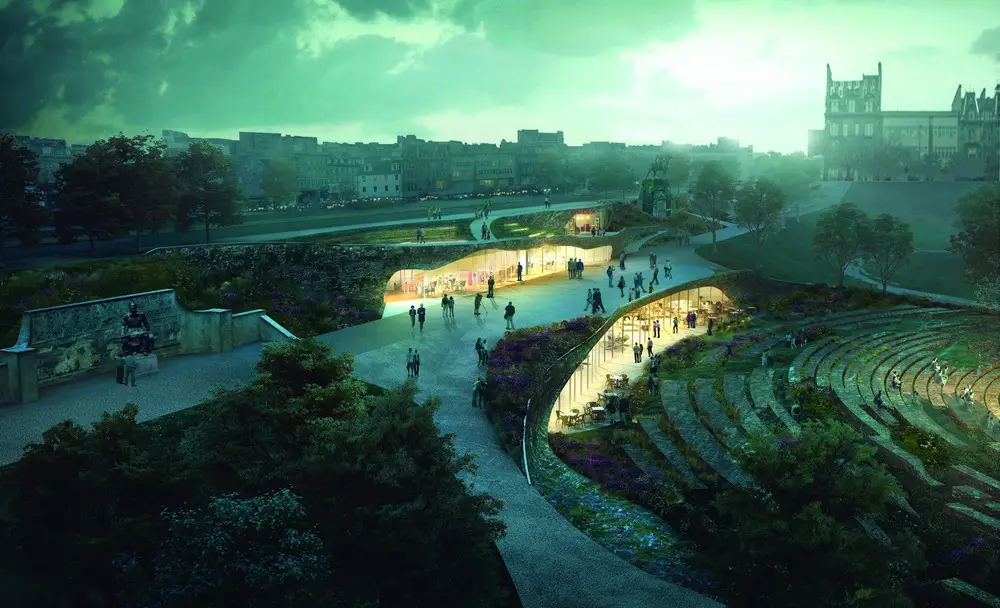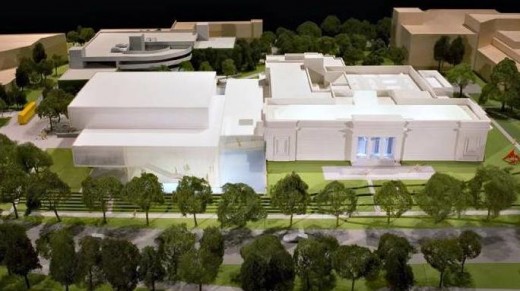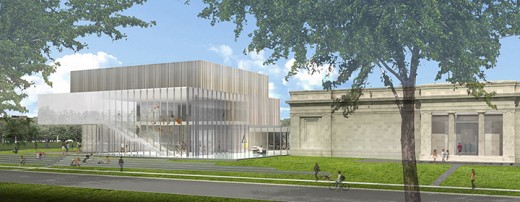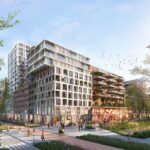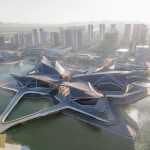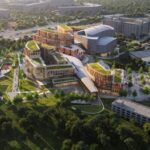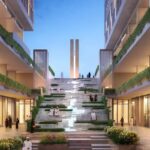Design: wHY architecture, Buildings, USA Architects Studio, Culver City Design Office, Photos, Projects
wHY architecture : Workshop Hakomori Yantrasast
Contemporary Los Angeles Architects Practice, United States of America: California Design Office News
Aug 2, 2017
wHY architecture news
wHY architecture – Ross Pavilion Competition Winner
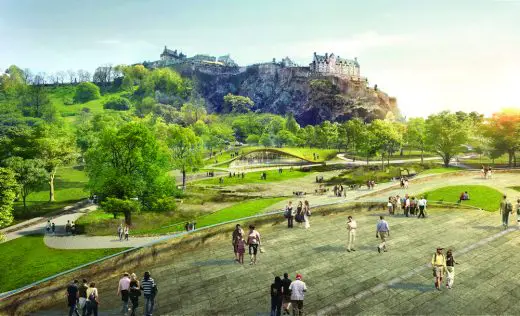
image courtesy of architects
wHY architecture – Ross Pavilion Competition Winner
This architects office based in Culver City, Los Angeles, California, United States – win this important international architecture competition in the heart of the Scottish capital city.
The L.A. design studio beat off competition from 125 teams from 22 countries to design the £25m project to revitalise West Princes Street Gardens.
Full design team: wHY, GRAS, Groves-Raines Architects, Arup, Studio Yann Kersalé, O Street, Stuco, Creative Concern, Noel Kingsbury, Atelier Ten and Lawrence Barth with Alan Cumming, Aaron Hicklin, Beatrice Colin, Peter Ross, Alison Watson and Adrian Turpin.
21 Mar 2016
Speed Art Museum, Third Street, Louisville, Kentucky, USA
The Speed Art Museum reopened its doors to the public on Saturday, March 12, 2016.
Ghislain d’Humières, Director of the Speed Art Museum said, “The new Speed will be an inclusive and welcoming environment that will engage visitors of all ages in conversations with each other and with the works of art”.
The success of the phase one capital campaign allowed for the completion of the Museum’s master plan, which includes a new North Building, a new South Building that includes a 142-seat cinema, a central utilities building, and an art park and piazza. The new public phase of the campaign consists of donations via the campaign’s website, changingspeed.org, or by texting Speed 365, where anyone can make a $10 donation at any time.
A look at the new Speed Art Museum
The new 62,500-sqft North Building will be largely transparent and will create one of the finest experiential art museums in the country. It will double the museum’s overall square footage and nearly triple the gallery space from the existing wing.
The expansion will create a new state-of-the-art space for larger special exhibitions, contemporary art galleries, a family education and welcome center, indoor/outdoor café, museum shop, and a multifunctional pavilion for performances, lectures and entertaining.
Additionally, the new Elizabeth P. and Frederick K. Cressman Art Park and public Piazza will feature a sculpture garden that will engage University of Louisville students and museum visitors alike. The Art Park will give the thousands of students who walk past the Speed each day on the adjoining UofL Belknap Campus the ability to mingle with great art and architecture.
The total expansion effort encompasses approximately 220,000 sq. ft., including 79,600 sq. ft. of renovation, 75,000 sq. ft. of new construction, and 135,000 sq. ft. of landscape
improvements.
Internationally renowned museum designer Kulapat Yantrasast of Los Angeles-based wHY Architecture created the design in association with K. Norman Berry Associates of Louisville.
Landscape architects Reed Hilderbrand from Boston designed the concept plan for the Museum’s setting along South Third Street on the northwest corner of the University of Louisville’s Belknap Campus, and local Landscape Architects, Carmen and Associates designed the landscaping plan.
Louisville philanthropist Hattie Bishop Speed founded the Speed Art Museum in 1925 with a belief in the power of art to change people’s lives. The Speed’s first building was designed by Louisville-based architect Arthur Loomis and opened in 1927; new structures were added in 1957, 1972, 1983 and 1996. The renovated Speed will have a natural flow through the building with a 67% increase in space for special exhibitions.
Despite the closure, the Speed continues to play an important role in the cultural and educational life of the region through community outreach initiatives, workshops, tours and art-related school programs. For more information on upcoming programs and events, visit www.speedmuseum.org.
About the Speed Art Museum
The Speed Art Museum is Kentucky’s largest art museum with a collection that spans 6,000 years of human creativity. An independent museum located on the campus of the University of Louisville, the Speed continues to play an important role in outreach initiatives, workshops, tours and art-related school programs. The Museum is situated at a crossroads between the city and the University of Louisville, adjacent to the busiest pedestrian thoroughfare on the University’s campus. The Speed is currently closed and undergoing a multi-phase expansion and renovation that includes a new North and South Building, 142-seat cinema, Art Park and a public Piazza. To view a virtual tour or for more information visit www.speedmuseum.org.
Source: Speed Art Museum
Major Design by wHY architecture
GRAM – Art Museum, Grand Rapids, Michigan, USA
2007
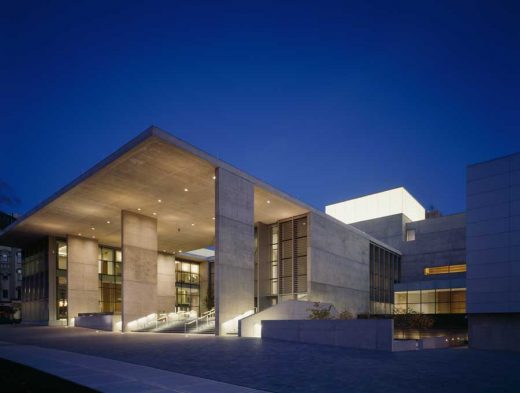
photo : Steve Hall@Hedrich Blessing
Grand Rapids Art Museum
The Grand Rapids Art Museum in Michigan is home to one of the oldest museums in the Mid-West. The new museum is designed through the integration of the arts and technology, and with a mission in obtaining a high-level certification from the Leadership in Energy and Environmental Design (LEED), thus making it one of the first art museums with such recognition.
The design stresses both the symbolic need of a museum to be a civic icon within the city, plus fulfilling humanistic needs for people to have their own experience with art.
Key Projects by wHY architecture
Design by wHY architecture, alphabetical:
Art Bridge, Los Angeles, California, USA
2009-10
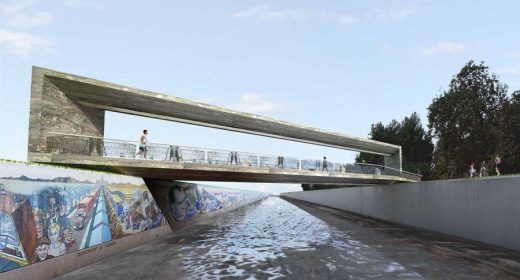
image from architect
wHY architecture : Great Wall of Los Angeles Interpretive Green Bridge
Casa Wakasa, Osaka, Japan
2006
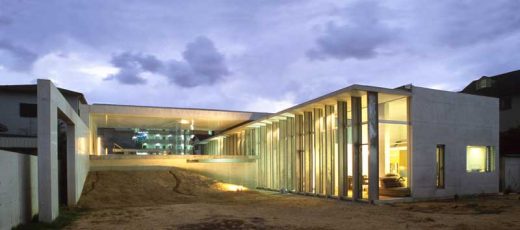
photograph : Koji Nagasawa
Osaka house
Chicago Institute galleries, USA
2007-
House, Los Angeles, California, USA
2007-
More projects by Design: wHY architecture online soon
Location: Culver City, Los Angeles, California, United States
Culver City ArchitectsPractice Information
Workshop Hakomori Yantrasast
This architectural office is based in Culver City, Los Angeles, California, United States
wHY Architecture founded in 2003 by Yo-ichiro Hakomori and Kulapat Yantrasast
wHY Architecture
Newsweek magazine article on contemporary architecture noted wHY Architecture as one of the innovative architectural practices for the new generation. Their philosophy of the integration of creative thinking with timeless design, along with their focus on intelligent and high-quality construction, have gained them a reputation for their architectural works and projects for the arts and culture as well as residences all over the country.
wHY Architecture was founded in 2003 by its two partners, Yo-ichiro Hakomori and Kulapat Yantrasast. Yo-ichiro received his Master of Architecture degree from the University of California, Los Angeles, and his Doctorate from the University of Tokyo. Kulapat, a native of Thailand, received his Bachelor of Architecture degree in Thailand and his Master of Architecture degree and Ph.D. from the University of Tokyo. While as graduate students at the University of Tokyo, they realized that they shared the same fundamental principles and goals of architecture which led to their collaboration on several design competitions and research projects.
After completing their degrees, they each worked for world-renowned architects on a variety of different projects prior to forming wHY Architecture. Yo-ichiro worked with the late Frank Israel and Arthur Erickson. Kulapat worked as a close associate and project architect for the Pritzker Prize laureate architect Tadao Ando on several major museums and large institutional projects in the United States and around the world, including the Modern Art Museum of Fort Worth, Texas, the ARMANI/TEATRO for Giorgio Armani in Milan, Italy, the Foundation Francois Pinault for Contemporary Art in Paris, France, the Calder Museum project in Philadelphia, Pennsylvania and the Clark Art Institute in Williamstown, Massachusetts. Both have continued to lecture and teach at universities around the country and worldwide, Kulapat has also served on the Artist Committee for American for the Arts, the nation’s oldest organization for the support of art in society.
Their works include many innovative architectural designs for people, the arts and the environments. The Grand Rapids Art Museum is the first new art museum in the world to receive the LEED certification. wHY Architecture has been working on many new gallery designs for the Art Institute of Chicago as well as the renovation and expansion of the historic Venice Jail into the new Social and Public Art Resource Center in Venice, California. Current projects also include the environmentally sustainable Art Bridge, at the Great Wall of Los Angeles River, made mostly from the trash salvaged from the river itself as well as many residential and commercial projects. wHY Architecture has also maintained architectural collaboration with Tadao Ando on significant museums and residential projects in the US.
As a workshop for creativity in design and construction, wHY Architecture continues their teamwork approach on every one of their projects and strives for new ideas and strategies in architecture executed with the highest degree of quality and intelligence in the construction.
Not to be confused with French architectural studio – whyarchitecture.com
Los Angeles Architecture Designs
Buildings / photos for the Design: wHY architecture page welcome
Website: wHY architecture Los Angeles

